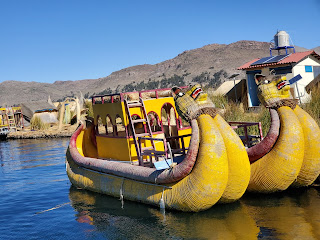We met Jorge as promised after breakfast at 8am and boarded our private boat right off the grounds of the hotel. Jorge gave us an excellent run down of the day’s schedule and started briefing us on the Lake.
We motored for about an hour before we got out of the “small” bay of Puno, and from there it was another thirty minutes to the island of Taquile. (). The island is populated by an indigenous group of close to 3000 people. We got off the boat on a rock formed dock, and followed Jorge slowly up, up and up along a concrete flagstone walkway that had recently been completed. The people here were fully autonomous from the Peruvian government, operating on a shared collective basis with local leaders. The island was about 7 kilometres long and several hundred meters high, as our burning lungs could attest. We had to take several breaks on the way up where Jorge used the gaps to fill us in on local customs of the Quechua speaking natives (Quechua is one of the 3 official languages of Peru, but I will be damned if I remember one syllable of the words Jorge tried to teach us!).
The views from the top of Isla Taquile were well worth it and we joined Jorge in doing a little three leaf Coca leaf offering for a wish at a small alter of their religion, which was a mix of seventh day Adventist’s and pagan environmental worship.
We hiked over to a little compound where we were given presentations as to how the men in the community were weavers and knitters, plying their craft not only for sale to tourists, but also for tightly woven (drum roll) traditions and celebrations that ran through their lives. One of the elders, Paulito, also showed us how a young thorn bush, once smashed with a pestle and ,iced with water became an all purpose, effective laundry detergent used by them to wash hair, bodies and clothing.
Maybe we should bring some on the trek!
Maybe we should bring some on the trek!
This was followed by a little song and dance put on by a small group, after which we were invited/forced to participate in....luckily my hands were full with the hands of a female weaver and could record that awkwardness...
Lunch was great - grilled rainbow trout that had been introduced into the lake by Canadians in the 1940’s. We walked another half hour, enjoying the views of the lake and the distant Royal Range section of the Andes in nearby Bolivia. We made our way down to a big sandy beach, where our boat had maneuvered to pick us up.
It wasn’t long before the eight of us were each taking up two seats on each side of the boat and were dozing as we headed back to the bay to check out the famed floating islands (Isla Flotantes or Uros Islands).
Here’s some travelreferatism that came to me as we approached the floating reed islands.... Inle lake in Myanmar... a completely water based culture, that although they didn’t float on water, their community was landlocked and completely unique to Beth and I when we were there in 1997. These floating communities are often panned as tourist created, hokey facades, but we had a different take.
We got off our boat and sat on reed benches, surrounded by reed houses all on a reed floor that is constantly added to in order to stay above water. Reed boats were moored nearby. The elder of this island of 20 people took us through a presentation, translated by Jorge, about life on the islands. It was fascinating and although we were baking in the sun reflecting off the reed floors, we were kind of captivated by his charisma and his little reed models he kept bringing ups from behind a reed table showing the entire community.
We walked around, checking out their crafts (of course) and some of us got dressed in their local garb for some pictures. Then, William and another woman had us board a medium sized reed boat where the other members of my party sat on the upper deck and I stood below for some pictures.
They rowed us in to a more developed (ie less reedy area, but still all built on floating reed islands) island they called the “capital” island that had permanent looking buildings featuring a church, general store and even a B&B. For some reason I still haven’t researched why, but we all got stamps in our passports (?).
The experience was great. Perhaps they don’t all live as traditionally as we were shown by William in the demonstration, but there was no doubt we’d experienced something very unique and it was just one more life experience we could give to ourselves and our kids to realize the world does not revolve around our customs and ideals.
We got back on our boat and motored through a water way amongst the reeds - we could have been zooming through the Everglades were it not for the occasionally colourfully dressed native fisherman or the clear lack of oxygen.
After another great meal at the hotel, we settled in to watch the semi final of the Cupa America featuring our team (Peru, of course) and the despicable (until we travel there, lol) Chileans. WE were big time underdogs but thanks to amazing goal tending, WE won 3-0! The staff went crazy, as far as the fairly reserved Peruvians would let loose. I know it’s not the World Cup, but damn if great sports results don’t follow this family.... Croat soccer, Peru... RAPTORS!






















No comments:
Post a Comment